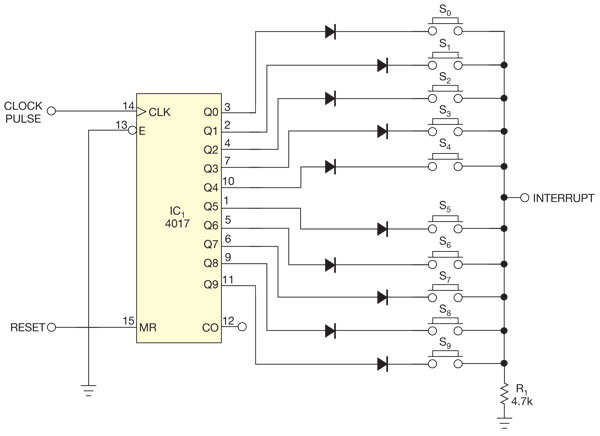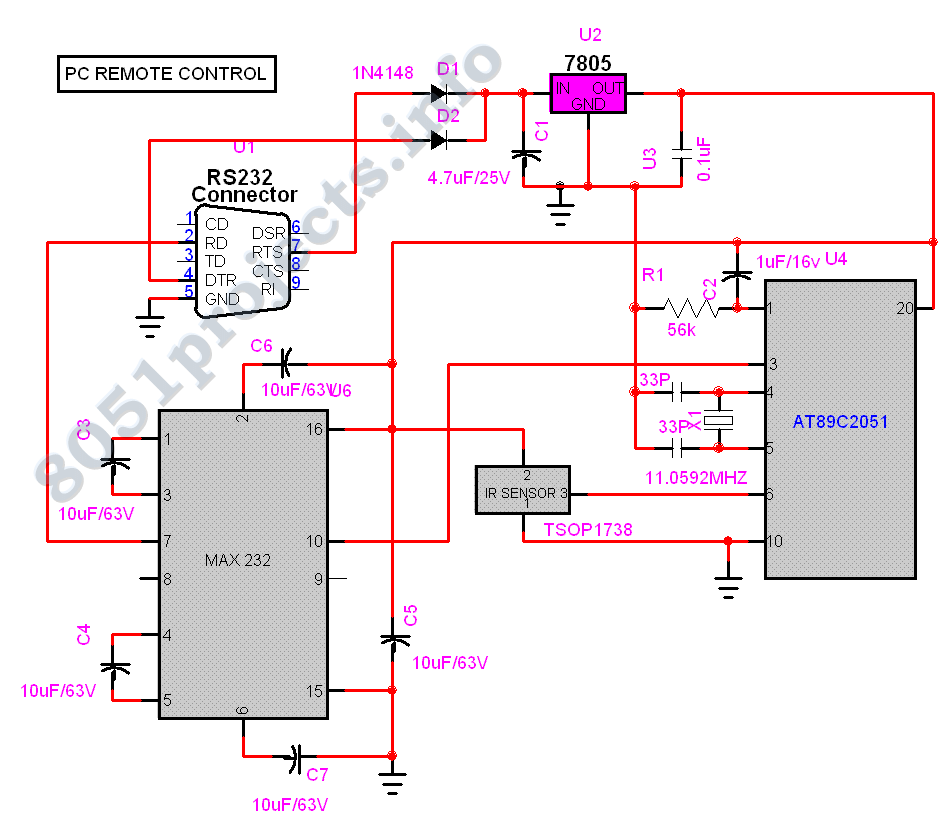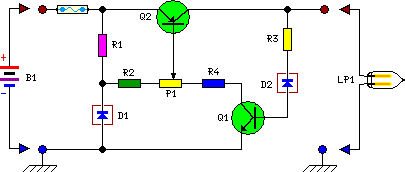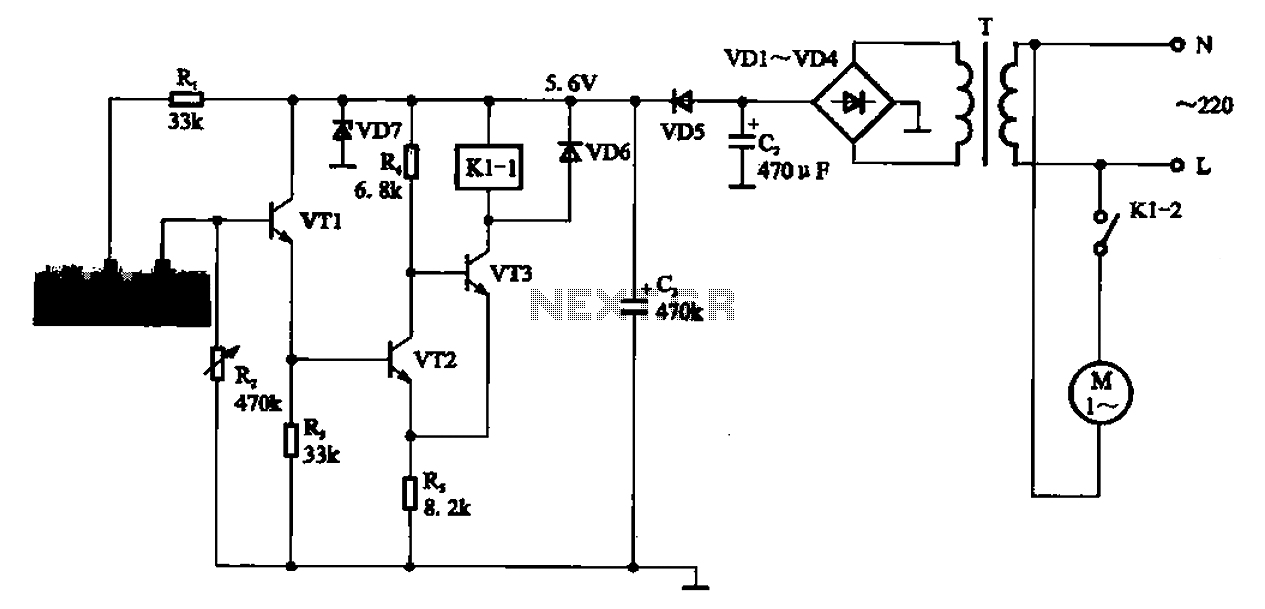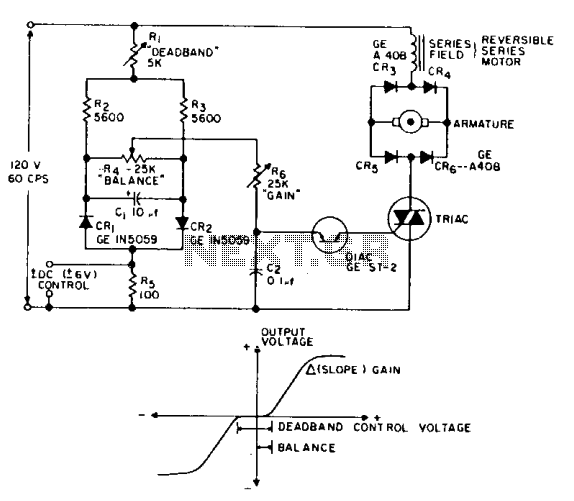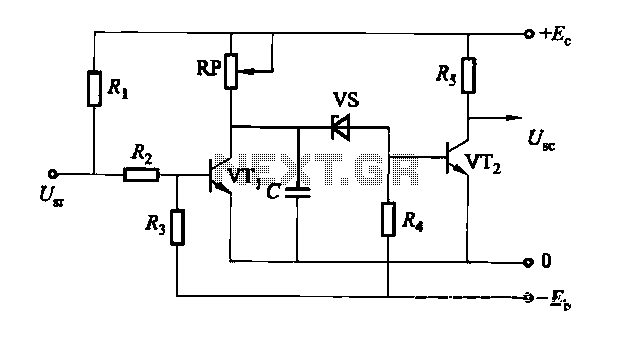
Dc servo bipolar control
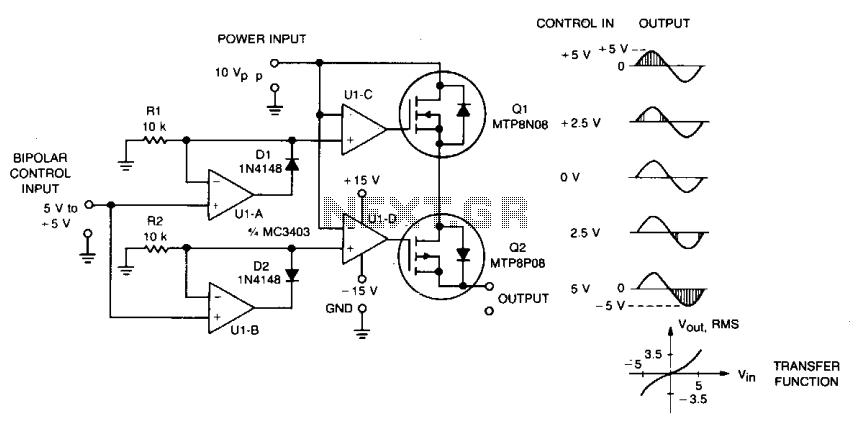
This circuit accepts bipolar control inputs of ± 5 V and provides a phase-chopped output to a DC load (such as a servo motor) of the same polarity as the input. The RMS voltage of the output is closely proportional to the control input voltage. N-channel and P-channel TMOS devices, Q1 and Q2, are connected in anti-series to form a bidirectional switch through which current can flow in either the forward or reverse direction. Control circuits turn Q1 and Q2 on when they are reverse biased, bypassing their reverse rectifier and increasing circuit efficiency. Each device is allowed to turn off only when forward biased. The Q1-Q2 switch connects the AC power source to the load when its instantaneous voltage is the same polarity and less than the control voltage. U1A is configured as an ideal positive rectifier whose output follows the control voltage when it is positive and is zero otherwise. Similarly, U1B is a negative rectifier. U1C turns Q1 on whenever the AC input voltage is lower than the positive rectifier output. For negative control voltages, Q1 is turned on only during the negative half-cycle. For positive control voltages, Q1 is turned on during the end portions of the positive half-cycle. Similarly, U1D turns Q2 on whenever the AC input voltage is higher than the output of the negative rectifier.
The described circuit operates as a sophisticated control mechanism for managing the power delivered to a DC load, particularly in applications such as servo motors. The bipolar control input of ± 5 V provides the necessary versatility for various operational scenarios. The core of the design relies on two TMOS devices, Q1 and Q2, which are configured in an anti-series arrangement. This configuration allows for bidirectional current flow, crucial for applications requiring control over both directions of current.
The control strategy employed in this circuit enhances efficiency by utilizing the reverse bias condition of the TMOS devices. When Q1 and Q2 are reverse biased, they are activated by the control circuits, which effectively bypasses the inherent reverse rectification that would otherwise occur. This design choice significantly reduces power losses, making the circuit more efficient in its operation.
The AC power source is managed by the Q1-Q2 switch, which only connects to the load when the instantaneous AC voltage matches the polarity of the control voltage and remains below it. This selective connection is vital for ensuring that the load receives the appropriate voltage levels, thereby optimizing performance. The inclusion of U1A and U1B as rectifiers is essential; U1A allows for the passage of positive control voltages while U1B manages negative voltages, ensuring that the circuit responds correctly to the varying input conditions.
The operational logic for Q1 and Q2 is governed by the outputs of the rectifiers. U1C enables Q1 whenever the AC input voltage falls below the output of U1A, facilitating control during the positive half-cycle. Conversely, for negative control voltages, Q1 is engaged only during the negative half-cycle, allowing for precise timing in the application of power. Similarly, U1D governs Q2, activating it when the AC input voltage exceeds the output of U1B, thus ensuring that the circuit can effectively manage both halves of the AC waveform.
Overall, this circuit exemplifies a robust design for controlling DC loads with AC power, leveraging advanced semiconductor technology and efficient control strategies to achieve optimal performance.This circuit accepts bipolar control inputs of ± 5 V and provides a phase-chopped output to a dc load (such as a servo motor) of the same polarity as the input. The rms voltage of the output is closely proportional to the control input voltage. N-channel and p-channel TMOS devices', Ql and Q2, are connected in anti-series to form a bidirectional switch through which current can flow in either the forward or reverse direction.
Control circuits turn Ql and Q2 on when they are reverse biased, bypassing their reverse rectifier and increasing circuit efficiency. Each device is allowed to turn off only when forward biased. The Q1-Q2 switch connects the ac power source to the load when its instantaneous voltage is the same polarity and less than the control voltage. Ula is configured as an ideal positive rectifier whose output follows the control voltage when it is positive, and is zero otherwise.
Similarly, Ulb is a negative rectifier. Ulc turns Ql on whenever the ac input voltage is lower than the positive rectifier output. For negative control voltages, Ql is turned on only during the negative half-cycle. For positive control voltages, Ql is turned on during the end portions of the positive half-cycle. Similarly, Uld turns Q2 on whenever the ac input voltage is higher than the output of the negative rectifier. 🔗 External reference
The described circuit operates as a sophisticated control mechanism for managing the power delivered to a DC load, particularly in applications such as servo motors. The bipolar control input of ± 5 V provides the necessary versatility for various operational scenarios. The core of the design relies on two TMOS devices, Q1 and Q2, which are configured in an anti-series arrangement. This configuration allows for bidirectional current flow, crucial for applications requiring control over both directions of current.
The control strategy employed in this circuit enhances efficiency by utilizing the reverse bias condition of the TMOS devices. When Q1 and Q2 are reverse biased, they are activated by the control circuits, which effectively bypasses the inherent reverse rectification that would otherwise occur. This design choice significantly reduces power losses, making the circuit more efficient in its operation.
The AC power source is managed by the Q1-Q2 switch, which only connects to the load when the instantaneous AC voltage matches the polarity of the control voltage and remains below it. This selective connection is vital for ensuring that the load receives the appropriate voltage levels, thereby optimizing performance. The inclusion of U1A and U1B as rectifiers is essential; U1A allows for the passage of positive control voltages while U1B manages negative voltages, ensuring that the circuit responds correctly to the varying input conditions.
The operational logic for Q1 and Q2 is governed by the outputs of the rectifiers. U1C enables Q1 whenever the AC input voltage falls below the output of U1A, facilitating control during the positive half-cycle. Conversely, for negative control voltages, Q1 is engaged only during the negative half-cycle, allowing for precise timing in the application of power. Similarly, U1D governs Q2, activating it when the AC input voltage exceeds the output of U1B, thus ensuring that the circuit can effectively manage both halves of the AC waveform.
Overall, this circuit exemplifies a robust design for controlling DC loads with AC power, leveraging advanced semiconductor technology and efficient control strategies to achieve optimal performance.This circuit accepts bipolar control inputs of ± 5 V and provides a phase-chopped output to a dc load (such as a servo motor) of the same polarity as the input. The rms voltage of the output is closely proportional to the control input voltage. N-channel and p-channel TMOS devices', Ql and Q2, are connected in anti-series to form a bidirectional switch through which current can flow in either the forward or reverse direction.
Control circuits turn Ql and Q2 on when they are reverse biased, bypassing their reverse rectifier and increasing circuit efficiency. Each device is allowed to turn off only when forward biased. The Q1-Q2 switch connects the ac power source to the load when its instantaneous voltage is the same polarity and less than the control voltage. Ula is configured as an ideal positive rectifier whose output follows the control voltage when it is positive, and is zero otherwise.
Similarly, Ulb is a negative rectifier. Ulc turns Ql on whenever the ac input voltage is lower than the positive rectifier output. For negative control voltages, Ql is turned on only during the negative half-cycle. For positive control voltages, Ql is turned on during the end portions of the positive half-cycle. Similarly, Uld turns Q2 on whenever the ac input voltage is higher than the output of the negative rectifier. 🔗 External reference
